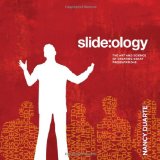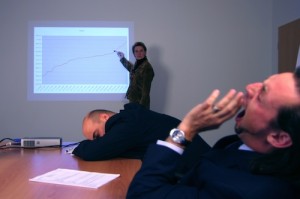Do you have a presentation coming up? No worries! Here are a few tips that will help you nail it. Be sure to let us know when our suggestions work for you. We love feedback!
Other categories:
Sales Negotiation
*************************************************************************************************************************
The power of pause
 Pausing has great power in any type of communication. A short pause between key points lets people know one point has ended, another not yet begun. It gives them time to digest and mentally “file” their thoughts before embarking on a new topic. From the speaker’s perspective, a pause steers your audience through key points, or gives time to weigh a response before giving an answer in Q&A.
Pausing has great power in any type of communication. A short pause between key points lets people know one point has ended, another not yet begun. It gives them time to digest and mentally “file” their thoughts before embarking on a new topic. From the speaker’s perspective, a pause steers your audience through key points, or gives time to weigh a response before giving an answer in Q&A.
How you can leverage a pause
Building pauses into your presentation builds in breathing room for everyone involved. We humans can process phenomenal amounts of information – just not all at once!
Pauses allow us to sort and store in our brains, and allow us “to make sense of it all”. By including time for this at strategic times in a presentation or conversation, you allow others to grasp and digest your key points.
- include blank slides between sections of a PowerPoint or Keynote presentation to give a visual pause.
- when speaking in front of a group, pause by scanning the room, moving to a different part of the stage or by stopping and simply gazing out to the audience for a moment before continuing to the next section of content. This tells everyone one part has ended, and another is about to begin.
- in a sales situation, pausing can give time to consider a deal, or give thought to an offer before responding.
- in a Q&A session, repeat the question back so everyone in the room can hear it, then pause before answering. This buys you time, and visually demonstrates a thoughtful response. It also allows everyone else to consider the question and anticipate your answer.
- take a deep breath and pause in stressful encounters. This calms your energy – and will likely have a ripple effect to those around you by slowing down the exchange.
Pausing gives everyone an opportunity to slow down, weigh ideas and prepare to respond or learn more. Leveraging the power of a pause will enhance your presentation of ideas by helping your audience to absorb your presentation content.
*************************************************************************************************************************
Quick warm-up with voice projection
This tip is a quick warm-up exercise before speaking in a large room. If you have access to the room, or one similar in size, you can practice this beforehand to get an idea of the acoustics.
- Stand straight and breathe in slowly to your diaphragm, until you cannot hold any additional air. Slowly exhale. Do this 3 times.
- Breathe in to your diaphragm and push sound from that space = use a one syllable word like “farm”.
- Face the far left corner and direct the word there. Then focus on the middle of the room and direct the word there. Finally, pick a point a few feet from where you are standing and direct the word there.
Notice how the sound and force will shift with each location. More power from your diaphragm (not your throat!) will propel the sound to far reaches of a room. Less force is required for sound close to you.
Tip: alter your eye contact and voice projection to different sections of your audience to include everyone.
As you practice this method of voice projection, you will notice over time that it can be used no matter the size of the venue.
*************************************************************************************************************************
Play to your strengths
Do you have a quick wit – or are you better with prepared notes? Play to your strengths, and watch how quickly you receive positive results!
How to identify your communication strengths
Who are your favorite speakers? Likely you gravitate to speakers who have similar strengths as yours.
Think of a presenter you liked.
What did you find interesting or engaging about their delivery? How do you have similar strengths?
What have others complimented you on?
Forget presenting: what is your natural way to communicate with family, friends & colleagues? This will translate to a larger venue as well.
Play to your natural communication strengths
Watch how your favorite presenters leverage their strengths when they speak. Can you do similar things? For example:
You love to tell stories: build stories in to illustrate how your plan will change company results.
You have a “folksy” nature, and relaxed attitude. Use this to draw your audience in and leverage a conversational style.
You have a dramatic flair – or were the “class clown” because humor comes naturally. Weave in drama or comedy for your delivery
Mirror Mirror: help me please!
We love mirror work as it gives safe feedback. After all, it is only you and the mirror – talk about a safe audience! Try out a few of your ideas by delivering the same lines in different modes. For example: “Hi I am Joe, and I am so glad to see you here today.” Deliver it to the mirror in a folksy manner. Then a dramatic manner. Then a humorous manner. Which feels most natural to you?
Try out several ways to deliver, and notice which ones feel “right” to you. These are your strength zones. Practice playing them in different ways until the delivery feels comfortable and second nature to you. By practicing and understanding what your unique strengths are, you will grow in your communication confidence.
*************************************************************************************************************************
Learn from the masters
What is the quickest way to learn? Simple: modeling behaviors of someone already doing what we’d like to accomplish. Children learn by observing their parents and other children. Then they mimic what they see. If you want to learn to be a great speaker, salesperson or teacher, find someone who already is and do what they do.
Speaking: view the best and take notes
What type of speaker do you admire? Find some footage of them in action – (see below for suggestions) – and observe. How do they enter the stage? Notice their timing, structure of their presentation and interaction with their audience. Then write down the top 5 things they do.
Good internet sources for speaking videos:
TED talks: the best of the best: http://www.ted.com/talks
Apple intros: Steve Jobs was a master, as is his team: http://www.apple.com/apple-events/
Idea Festival: similar to TED, a vast library on tons of topics: http://www.ideafestival.com/
YouTube: historic speeches, current speeches, you name it.
Review your notes, apply, then watch again
Review your notes on what you think works for your favorites and apply these insights to a presentation you recently did. How could you incorporate these very things to improve? As you write your thoughts out, visualize how you might have delivered your presentation differently.
Then, go back and view the videos again. Do you notice any difference? What other insights might you use?
By observing great speakers, you will begin to pick up what makes them so memorable and powerful. Body language, voice projection and pace and structure of their presentation will become clearer as you pay more attention. Adding these skills to your tool kit will elevate your delivery as well.
*************************************************************************************************************************
Improve your speaking success by knowing how to prepare
Preparing and rehearsing. Two vital actions for wowing your audience – whether an audience of one or thousands. Giving a speech can elevate your business and career, and taking these simple steps can improve your success.
 Know how to prepare
Know how to prepare
Asking the right questions in advance can save you mountains of heartache and time. An easy formula to use is the old journalism rule of “who, what, when, where and why”.
Who: more than your audience
Many people can help you deliver quality results on the “big day”. Consider if you need to know about the following people:
- Event coordinator: if you are giving a speech, is there a person to answer your questions and assist with materials, delivery, and access to the venue to rehearse? Event coordinators can be your greatest ally and asset in preparing for the event. They generally know the venue staff, can tell you where to ship materials and arrange for on the ground support. They can also give you advance schedules, information about your fellow presenters and samples of event materials.
- AV team: if you rely on video, PowerPoint or other electronic related delivery means, knowing who the lead AV person is can be invaluable. Will you need a specific format? Internet connection? Do you use a Mac & they use PC? What type of mic will you have? Your event coordinator can connect you with this team.
- Fellow presenters and MC: who else is presenting, and what are their topics? Creating content that builds on central themes will prove effective for your audience. Also, does the Master of Ceremonies have your bio, know how to correctly pronounce your name, etc.? If at all possible, introduce yourself to the MC in advance. It may improve how your introduction comes across.
What: your topic
An adviser once told me his critical lesson as a teacher came from a friend who said: “Your job is not to teach them everything you know, but to teach them what they don’t know about your topic.” Well said.
Hone in on one central theme and a few supporting points. Too many speakers go forth with so much information that the audience cannot absorb it. You want people to remember you as making something simple to understand and remember. Editing achieves this.
When: timing is everything!
When will you present? Early in the morning when energy is high? Or, the dreaded post- lunch “I want a siesta” time slot? Knowing what part of the day or conference you have as a time slot can help you prepare for your audience’s likely energy level and attention span.
- Top times of focus: beginning of day or conference; take advantage and keep your energy level and animation high.
- Sluggish times: post lunch, and mid afternoon (3 pm); add interactive questions, prizes, have people stand up in response to questions.
- People wandering in: post-workshop; save biggest points for five minutes in and periodically recap what you’ve already said. Repetition aids retention for those already present, and help stragglers get oriented quickly.
Where: know the room
Room size and configuration can shape how you choose to deliver your information. Small groups make PowerPoint delivery awkward. Large venues require mics. Will light be in your eyes? Do you enter via stairs, or from backstage? Knowing all of these answers in advance will increase your comfort and confidence. If at all possible, ask to see the room in advance, and rehearse a dry run beforehand. Tip: many national hotels have similar configurations. If you cannot get early access at the live event, a local site may have a similar room to show you.
Why is everyone here in the first place?
The true reason everyone made the time to listen, maybe even paid money and travelled, is the starting point. Why do they want to hear what you have to say? Think of this as your starting point, and the content will come to you easily. If ever in doubt, go back to this question and ask yourself if your content delivers to their “why”.
Pay attention to the “5 W’s” and add #6: Winning appreciation
By paying attention to the “who, what, when, where and why” of your speech, you will earn the appreciation of your audience. Poise comes through confidence, and confidence accompanies preparation. Preparing with the “5 W’s” will set you up for a successful speech.
*************************************************************************************************************************
Give ‘em something to remember
How can you make certain an audience will remember your point two weeks from now? One method is to create a S.T.A.R. moment in your presentation: Something They’ll Always Remember.
Nancy Duarte, presentation guru and head of Duarte Design, gives several examples of S.T.A.R. moments in her latest book, Resonate. There are five basic types of S.T.A.R. moments:
- Memorable dramatizations (props, demos and skits)
- Repeatable soundbites (“I have a dream”)
- Evocative visuals (compelling images which evoke emotions)
- Emotive storytelling (case study, hero overcoming great odds, childhood memory)
- Shocking statistics (“It takes 26 oz of crude oil to produce a cheeseburger.”)
S.T.A.R. moments should illustrate the core point you want to make – the takeaway for your audience. Think of ways to showcase your point in a way that people will remember.
By building a S.T.A.R. moment into your presentations, you will increase the likelihood that your audience will remember your point – and you – over time.
*************************************************************************************************************************
How to craft a killer presentation: act “as if”
One of the core catch phrases for improv is “act as if”. What it means is this: when you start a scene, you must create it into a reality the audience believes. In other words, you create something that doesn’t exist by acting “as if” it is happening.
How does that apply to business? Many ways: creating a sale that didn’t exist, making an organization change or adding a new product or service. Try taking these steps when drafting your next presentation or call:
1) In your mind, act “as if” the situation is already happening. For example: if your company is now $500,000 in sales, what would be different if it was $1,000,000? What would that look like?
2) Write some notes about how the ideal situation would unfold.
3) What questions are likely to come up from your audience?
4) What is the best venue? Telephone, one-to-one or a group?
5) Create a story board for your presentation. Capture each segment: greeting, small talk, presentation, Q&A, closing the deal – anything likely to occur.
As you create your story board, read it out loud. This exercise usually surfaces any awkward gaps and information you need to add or delete.
By drafting out the presentation in advance, and acting “as if” it is really happening, you clarify your message and increase the likelihood of the ideal outcome.
*************************************************************************************************************************
Tips for selecting images
Visual communication through images helps people remember your message. We often recall color, shape and emotion and link it to the context or message. (See last week’s post where we covered how to make an effective iPad presentation.)
Selecting images does require some thought and planning. Here are some tips:
 Choose images to reinforce your story. Images provide visual communication, just as words provide context.
Choose images to reinforce your story. Images provide visual communication, just as words provide context.
- Keep images to a similar color palette throughout your presentation. This keeps everything cohesive. For example: keep images in the blue, green or brown color scheme.
- Break the color pattern only to make a point. The interruption signals “pay attention!” Red is a great color choice to make your strongest point. Once you’ve made the point, then you can return to the original color scheme, or start a new one to reflect the change.
- Choose images with consistent layouts: all horizontal (landscape) or vertical (portrait) orientation.
- Properly size your images and keep the sizing consistent. A slide with a white border does not flow with images that cover an entire slide.
- Keep in mind that viewers will follow the gaze (line of sight) the people/animals in the photo have. If a child gazes to the right – and the right is looking off of the page, viewers will look off of the page instead of reading the words on the left. The simple remedy for this is to use the “flip image” option in your editing panel.
Slideology by Nancy Duarte, is a great book for creating powerful presentations. She covers this topic and others in depth, with easy to follow examples.
Using thoughtful and cohesive images for your presentations will give viewers more sensory information to recall your content. By taking the extra time to include these steps, your presentation effectiveness will improve. Try it and see!
*************************************************************************************************************************
How to “bookend” so people remember your points
We all get bombarded with messages throughout the day, and do not remember everything we hear. How can we insure that our message makes it through the clutter so others will remember?
By “bookending” your points with a clear start and finish, people can absorb your idea, and have higher retention. Bookending begins and ends with clearly stating your idea – hence the term “bookend”. It follows a simple pattern:
State your idea
Explain the concept (briefly)
Illustrate it with an example, preferably one your audience will likely encounter
State the idea
Pause 30 seconds before moving on to the next point. This gives people time to absorb what they just heard before you move on to another topic.
This technique is especially effective if you have multiple ideas or points to communicate. By beginning with the idea and ending with the idea, you’ve created a clear start and end point for people to follow. The final pause gives everyone an opportunity to absorb (and retain) what you’ve said.
You can apply bookending to conference calls with your team, in a sales presentation or a formal presentation. Try it and see the results!
*************************************************************************************************************************
Avoid these 7 presentation mistakes
When planning your presentation, make it clear and easy for your customers or audience to understand. Here are the top 7 mistakes to avoid:
- Too many bullet points: anything more than one is too much on a PowerPoint®, more than three is too much on a handout.
- Tiny type: usually because of too many bullet points. People can’t read the words.
- Spreadsheets on a slide: instead, take the point you want to make, and put that on the slide. If you must, either hand out the spreadsheet or include in the Appendix.
- Clip art: cheesy clip art can diminish credibility.
- Different fonts: cut and paste changes often bring different types of font. Do a run-through before you lock in the final file to verify that each slide has the same font.
- Placement jumping: this happens when we move images and text boxes around to fit everything on a page. Unfortunately, the eye picks up the change as a tick in consistency when all the other slides don’t match. To avoid this, turn on the “grid” option in your slide ware program, or look for the “x” and “y” axis numbers to match. (You can see these when you roll over the image or box.)
- Pictures in different color tones: professional designers know this small detail makes a large difference. If you use stock photos, keep them in the same color range – if the backgrounds are cool blues, carry that through to all of your photos to convey consistency.
Bonus tip: To make a point really stand out: break one of these rules! For example: have all images in one color palette except the big “aha” slide – have that slide in a stand-out color. Hint: reds and oranges work well for this.
Resource:
 Nancy Duarte wrote this fantastic reference book with very specific “how to’s” on creating compelling presentations. We like it so much, there are two copies in our reference library. Both have post-its all over them.
Nancy Duarte wrote this fantastic reference book with very specific “how to’s” on creating compelling presentations. We like it so much, there are two copies in our reference library. Both have post-its all over them.
*************************************************************************************************************************
Presentation magic: one idea at a time
If you have a big presentation coming up, whether a one-on-one sales call or a presentation to an entire company, here’s a magic tip: keep focused on one idea at a time. Here’s what we mean:
Each page or screen should have one key point to make.
Most people absorb one thing at a time. If you present to a large group using PowerPoint®, Keynote® or another slide show software, be ruthless in allowing only one point per slide. Ask yourself “what is the one key thing I want everyone to remember?” That is what should go on the slide.
The common mistake we’ve all made
A common mistake all of us have likely made is to  cram too much information onto a slide. We call these “eye charts” because they are so difficult for the audience to read.
cram too much information onto a slide. We call these “eye charts” because they are so difficult for the audience to read.
Instead, include the key takeaway point you want people to remember. All the other stuff can be supporting points as you speak, included in a handout or stored online with a link you can direct audience members to. (The link, by the way, can reinforce any sales information or offers if it leads to a well crafted landing page.)
*************************************************************************************************************************
How to hear people when you are really tired
Active listening takes energy. Lots of energy. Have you ever found your attention wandering off in a meeting, or even a social event? Sometimes chanting “focus, focus” doesn’t quite do the trick. For those times, these improv tips may come in handy:
Tip #1: Participate with last word, first word: make the last word of a persons sentence the first word of your next sentence.
Tip #2: Breathe! Inhale deeply, exhale slowly. Do this 3 times, and energy may amp up.
Tip #3: Repeat back: ask a clarifying question. For example: “I want to make certain I understand correctly, did you mean…..?” This has the double advantage of involvement (to create focus) and letting the speaker know you truly value what they say.
These tips mean physically participating – speaking or breathing – and change the energy pattern. Also, by creating a challenge to yourself with asking questions or remembering one word to repeat back, your mind then takes on the challenge of performance and participation.
*************************************************************************************************************************
Show your audience some love
Our Valentine’s Day tip: how to love your audience by including them.
to love your audience by including them.
Have you ever listened to a speaker you felt had no regard to you even being there? Even in a small meeting at work? Here’s how to avoid that, and show your audience some love: scan, pause, speak.
Scan the room, share your eye contact – whether a conference table with six or an amphitheater with 600, include everyone by sharing your gaze. By looking at a person (or section, if an amphitheater). By looking in someone’s direction, you’ve included them through your gaze, body language and speech.
Pause. Once you’ve looked at someone, pause briefly, then speak. When you pause for just a beat – maybe a second – this gives the person a moment to register that they are now on your radar.
Speak to them. This signals that they are important to you, enough to include them in your conversation.
Do this every few sentences or so. If you sense attention slipping, bring that person or group back in by looking in their direction, pause, and speak. Keep moving and including people throughout your presentation and your audience will love it!
Happy Valentine’s Day!
*************************************************************************************************************************
How a mirror can polish your delivery
Practicing a sales call or big presentation in front of a mirror will help you see yourself as others do. A little warning here – just about everybody feels really uncomfortable with this at first. Hang in there (trust me on this one!). It really will make a remarkable difference.
- Run through your pitch without looking at notes.
- Close your eyes, breathe, and imagine feeling confident.
- Open your eyes and run through again.
- Are you open and friendly? Try again and see how a winning smile can make a huge difference!
Keep doing this until you feel confident and comfortable with the delivery you’d like to make. By the time you get to the actual “real life” delivery, it will feel second nature to you!
*************************************************************************************************************************
How to defeat stage fright: 2 quick tips
Have you struggled with stage fright before a big presentation? Banish the butterflies in your stomach or those shaking fingers with these two proven tricks: take 3 deep breaths and amp positive energy with motion.
Calm nerves with 3 deep breaths
Actors get stage fright, too, and often rely on the proven “3 deep breaths” to calm down. Simply close your eyes, shoulders back and heads up. Place your hand on your diaphragm and inhale deeply. If you are doing this correctly, your hand will move as your diaphragm inflates. Much like a big festive balloon! Think of a lovely balloon or other calming visual as you slowly count to 3. Then, push your breath out in short bursts, exhaling air through your mouth until you feel there is no air left to push from your diaphragm. Do this 3 times. You will feel calmer, more at ease. Now: shoulders back and on to the presentation with confidence!
Amp energy with a burst of motion
Want to amp energy instead? Try quick tip number 2: run rapidly in place for one minute. As you run, say over & over: “confidence, confidence, confidence”. This links your words to the action. When you are done, stand straight, head up with your eyes closed and smile. Tell yourself “I am awesome! I am giving great information!” Then, visualize a terrific outcome, with people reacting favorably to your presentation. Smile again, open your eyes and go!
Keep adding and trying tools like these. Over time, you will have a few quick favorites that work best for you, and help banish stage fright forever!
*************************************************************************************************************************
How to help people “see” your idea
Convincing people your idea has merit flows more easily if you guide them through scenarios.
Most of us try to picture ourselves in a situation to understand what it is like. Think of how you make faces when watching a movie, depending on the actor’s position. Have you ever ducked when a spaceship flew toward the audience, then sheepishly looked around to see if anyone else did the same thing? We all react!
When you have a plan to explain, or a product to sell, it helps if you can guide your audience to understanding by creating stories they can relate to. For example: if you reorganize your department, help people understand the new structure by creating some scenarios they will likely encounter. If you will now outsource artwork, show your team how this works through an example:
“We can now outsource artwork! That means we are no longer constrained to wait on our in-house group. The overload caused us to miss several deadlines last year – which nobody enjoyed. Nancy, let’s say we have a major catalogue to send out. You can now interview 3 different agencies or freelancers and choose the one which best suits the client needs. It means a lot more flexibility for you, and far less frustration.”
This example recaps the frustrations the department had before, and recalls the emotions each member felt. The new option is illustrated by showing how a specific team member can have more flexibility. Each member can “see” how they will benefit, and understand the change through empathy.
By helping your team identify how the change will affect them through scenarios, their understanding and buy-in will improve.
*************************************************************************************************************************
The secret ingredient to a good story
Do you ever wonder why some stories catch your attention, and others don’t? Here’s the secret: it’s all about the “who”. Every good story has good characters. People identify with the struggles, joys, fears and other emotions of the characters. Here are three tips to creating compelling characters, the “who” of your story:
Tip #1: Create your characters with your audience in mind
We like to identify with the characters in a story. Think of who will hear the story, and what you want to convey. For example, if you tell a story about a business using your service, include the decision makers as the characters. What do they consider? Who are they? People like to put themselves in the character’s place to follow the story. Make it easy for your listeners or readers to identify with your characters.
Tip #2: Show the inner dialogue
What goes on beneath the surface fascinates us. Think of how you can show what’s going on inside your character’s head. For example: let’s say you are calling on a customer to sell a new service. A case study of a similar customer can show the struggle and outcome. Show the concerns of failure, the fear of risk, the courage of deciding on a course of action. How did the outcome affect the customer? Could they expand, grow, or get promoted? What secret questions are they really asking themselves? Bring these to light.
Tip #3: Include emotional detail
Emotional detail acts like the glue to keep us interested. Every good story includes the emotions characters experience. Noble heroes feel the emotions and move forward in spite of them. Consider classic movies that drew you in. Watch the characters and the emotional detail they conveyed.
Draw people in to your story
The most fascinating part of a story always revolves around the characters. Circumstances, premise and setting all support the central focus of the “who”. Great leaders always have a stockpile of stories to illustrate their point. Great companies focus on the “who” of their customer. By becoming comfortable with creating characters, you will engage people with your topic.
*************************************************************************************************************************
How to create a story: Beginning, middle and end
Every story has a beginning, a middle and an end. The beginning opens your story, and sets the stage for what is to come. The middle has the action, with players acting out the heart of the story. The end resolves the action – and “wraps the story up”. Post scripts can be added to include a “what happens after the story”, like the film credits at the end of a movie telling what happened to each character later.
Begin with the end in mind
Business stories run the gamut from inspiring your team to selling a plan of action or product. We recommend that you “begin with the end in mind”.
For example: you have just purchased a competing company, and now want to speak to both company teams about the future. The end you have in mind is to reassure your teams, and give them confidence that the merging of cultures will go smoothly.
Quick formula for business stories
Here is a quick formula for building your story:
- Beginning: set the stage for what is to follow. Introduce conflict early
- Middle: the drama: play out the conflict
- End: the solution: solve the conflict
- Post script: what is next, what to do (call to action)
For our merger example, a story could go something like this:
A month ago, we had two separate companies – fierce competitors in the marketplace. Each of us experienced a lot of success. Each has strong people who value achievement. And that can lead to conflict. The difference in our cultures means that clashes are bound to occur, and we want to avoid that. How? By focusing on the best of both cultures, and creating an even stronger culture as we move forward. This may mean more conflict in the short term, but a stronger team in the long run. Beginning next week, we will pair departments to hash out a joint plan of working together and agreeing on our goals for this year.
By taking each situation and crafting a progression of beginning, middle and end, your audience will know what to do.
*************************************************************************************************************************
5 Ways to capture a story so people remember your point
Everyone loves stories. As children, we plead with parents to “tell us a story”. Movies, radio and commercials all entertain us through story. We tend to recall more information from a story than a list of facts or charts.
Because of this, stories offer a powerful way to communicate in business. The next time you have a presentation to make, try to capture the story you want to tell. Here are 5 ways to do just that by focusing on the point you want people to walk away with.
1) Does a new product make life easier for someone? Capture the “before and after” story and contrast them.
2) Are you trying something different? Capture the “future story” of how things might be.
3) Are your profits down? Capture the “numbers story” of how expenses in an area grew faster than another – and the “solution story” of how you can create a new outcome moving forward.
4) How does the “customer experience” story sound from the customer’s point of view? Apple does a brilliant job with this showing their products in use.
5) Will you be working with another company or team? Capture the “best friend” story, sharing new journeys.
Stories illustrate your points. It doesn’t matter if your presentation is one on one, or a national event presenting to hundreds. The principle is the same.
Try it. See the results.
*************************************************************************************************************************
3 quick ways to build confidence
In every workshop we do, the most common objective is “I want to be confident.” People respond to confidence, we are drawn to it because it conveys some certainty in an uncertain world. Yet, most of us struggle with our own levels of confidence.
Here are 3 quick ways to re-establish confidence when you need it. (e.g. before a big meeting, presentation or sales call)
1) Remember. Everyone has a memory of a time when you owned the moment. You did well. You performed at your best. You OWNED the moment. Top of your game. Remember that moment. Close your eyes and remember every single detail and what it felt like in your body and mind. How did you stand? Where were your shoulders? What did your face feel like? Remember how you breathed, how you stood, what your cheekbones felt like. Every single detail. Replicate it as you remember. Feeling the physicality of confidence in YOUR body is what will carry you forward.
2) Visualize. Now that you know exactly how you feel when you are confident, keep your body in that state as you imagine the new event unfolding perfectly. See in your mind how you stand and speak and perform. Know it. Own it. And repeat this “film reel” in your mind over and over. Trust me, this works. Olympic athletes run through their events like this. Airline pilots rely on flight simulators. See yourself as confident and successful. Imagine the compliments and congratulations you receive and how that feels in your body.
3) Energize! This one amps up your physical energy and really gets the endorphins working in your favor. Run in place, close your eyes, recall your vision and repeat out loud: “confidence, confidence, confidence. I AM confident!” Then run the visualization through your head again as you do this. Finish by standing tall, taking a deep breath, and telling yourself “I can do this!” Then square your shoulders and get out there!
Follow these three as many times as you can. Do them regularly and it becomes second nature. Your confidence will grow with each success.
And, please, let us know your successes! We’d love to share them.
*************************************************************************************************************************
Know your audience:
Expert presenters have a #1 rule: know your audience. Before crafting any type of presentation, first understand who will be listening, why they are there, and what is important to them.
 Have you ever endured a product presentation that features screen after screen of whiz-bang stuff the product can do – and only an engineer could love? Although I admire the passion behind the “tell us everything about it”, the effect doesn’t move careers ahead.
Have you ever endured a product presentation that features screen after screen of whiz-bang stuff the product can do – and only an engineer could love? Although I admire the passion behind the “tell us everything about it”, the effect doesn’t move careers ahead.
Instead: think of who you are addressing and how they might use the product. Will it reduce time to prepare something? Could they do their job better? Will it assist in meeting bonus objectives?
As a very wise friend told me: “My teaching career took off when I realized my job was not to teach them everything I know, but to teach some things they don’t yet know.”
*************************************************************************************************************************

